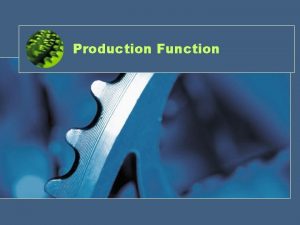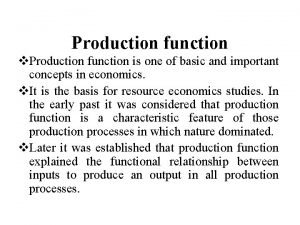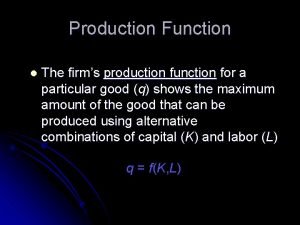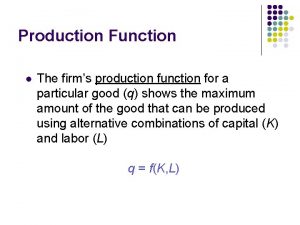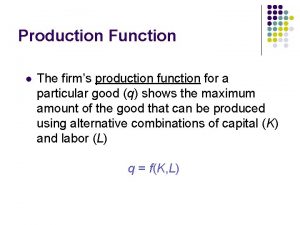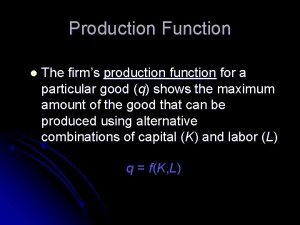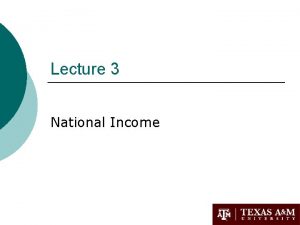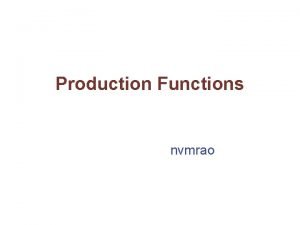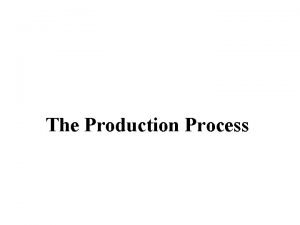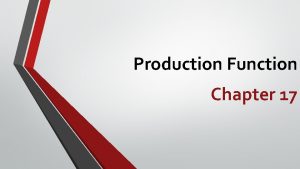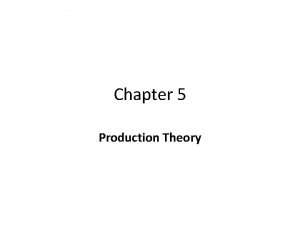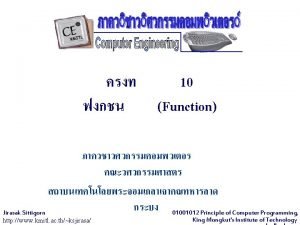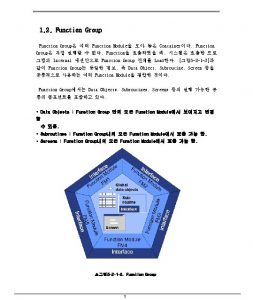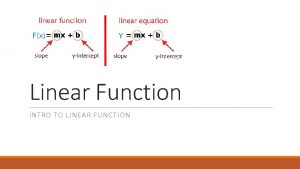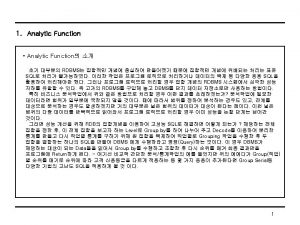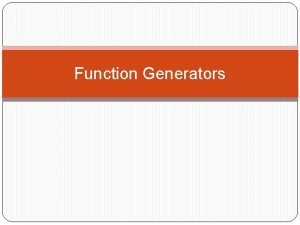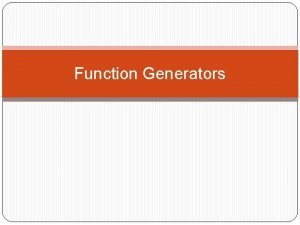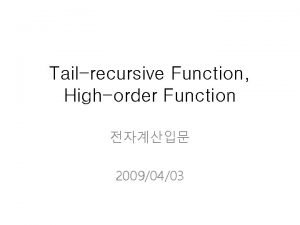The Technology of Production n n Production Function

































- Slides: 33

The Technology of Production n n Production Function: l Indicates the highest output that a firm can produce for every specified combination of inputs given the state of technology. l Shows what is technically feasible when the firm operates efficiently. The production function for two inputs, for a given technology: Q = F(K, L) Q = Output, K = Capital, L = Labor Chapter 6 1

Production Function for Food Labor Input Capital Input 1 2 3 4 1 20 40 55 65 75 2 40 60 75 85 90 3 55 75 90 105 4 65 85 100 115 5 75 90 105 115 120 Chapter 6 5 2

Isoquants n Assumptions: Food producer has two inputs: Labor (L) & Capital (K) n Observations: 1) For any level of K, output increases with more L. 2) For any level of L, output increases with more K. 3) Various combinations of inputs produce the same output. n Isoquants: Curves showing all possible combinations of inputs that yield the same output Chapter 6 3

Production with Two Variable Inputs (L, K) Capital per year The Isoquant Map E 5 4 3 A B The isoquants are derived from the production function for output of of 55, 75, and 90. C 2 Q 3 = 90 D 1 Q 2 = 75 Q 1 = 55 1 Chapter 6 2 3 4 5 Labor per year 4

Isoquants The Short Run versus the Long Run n Short-run: l n Period of time in which quantities of one or more production factors cannot be changed. These inputs are called fixed inputs. Long-run l Chapter 6 Amount of time needed to make all production inputs variable. 5

Production with One Variable Input (Labor) Amount of Labor (L) Amount Total of Capital (K) Output (Q) 0 10 0 --- 1 10 10 2 10 30 15 20 3 10 60 20 30 4 10 80 20 20 5 10 95 19 15 6 10 108 18 13 7 10 112 16 4 8 10 112 14 0 9 10 108 12 -4 10 10 10 -8 Chapter 6 Average Product Marginal Product 6

Production with One Variable Input (Labor) 1) With additional workers, output (Q) increases, reaches a maximum, and then decreases. 2) The average product of labor (AP), or output per worker, increases and then decreases. Chapter 6 7

Production with One Variable Input (Labor) 3) The marginal product (MP) of labor or output of the additional worker increases rapidly initially and then decreases and becomes negative. . Chapter 6 8

Production with One Variable Input (Labor) Output per Month D 112 Total Product C 60 A: slope of tangent = MP (20) B: slope of OB = AP (20) C: slope of OC= MP & AP B A 0 Chapter 6 1 2 3 4 5 6 7 8 9 10 Labor per Month 9

Production with One Variable Input (Labor) Output per Month Left of E: MP > AP & AP is increasing Right of E: MP < AP & AP is decreasing E: MP = AP & AP is at its maximum When MP=0, TP is at its maximum 30 Marginal Product E 20 Average Product 10 0 Chapter 6 1 2 3 4 5 6 7 8 9 10 Labor per Month 10

Production with One Variable Input (Labor) The Law of Diminishing Marginal Returns n As the use of an input increases, a point will be reached at which the resulting additions to output decreases (i. e. MP declines). n When the labor input is small, MP increases due to specialization. n When the labor input is large, MP decreases due to inefficiencies. Chapter 6 11

Production with One Variable Input (Labor) The Law of Diminishing Marginal Returns n Can be used for long-run decisions to evaluate the trade-offs of different plant configurations n Assumes the quality of the variable input is constant, and a constant technology n Explains a declining MP, not necessarily a negative one Chapter 6 12

The Effect of Technological Improvement Output per time period Labor productivity can increase if there are improvements in technology, even though any given production process exhibits diminishing returns to labor. C 100 B O 3 A O 2 50 O 1 0 Chapter 6 1 2 3 4 5 6 7 8 9 10 Labor per time period 13

Malthus and the Food Crisis n Malthus predicted mass hunger and starvation as diminishing returns limited agricultural output and the population continued to grow. Why did his prediction fail? n The data show that production increases have exceeded population growth. n Malthus did not take into consideration the potential impact of technology which has allowed the supply of food to grow faster than demand. Technology has created surpluses and driven the price down. n Question: If food surpluses exist, why is there hunger? Chapter 6 14

Production with One Variable Input (Labor) n Labor Productivity: AP = Total Output/Total Labor Input n Labor Productivity and the Standard of Living: Consumption can increase only if productivity increases. n Determinants of Productivity Chapter 6 u Stock of capital u Technological change 15

Labor Productivity in Developed Countries France Germany Japan United Kingdom United States Output per Employed Person (1997) $54, 507 $55, 644 $46, 048 $42, 630 $60, 915 Annual Rate of Growth of Labor Productivity (%) 1960 -1973 4. 75 4. 04 8. 30 2. 89 2. 36 1974 -1986 2. 10 1. 85 2. 50 1. 69 0. 71 1987 -1997 1. 48 2. 00 1. 94 1. 02 1. 09 Chapter 6 16

Production with One Variable Input (Labor) n Explanations for Productivity Growth Slowdown 1) Growth in the stock of capital is the primary determinant of the growth in productivity. Rate of capital accumulation in the US was slower than other developed countries, due to necessary rebuilding after WWII. 2) Depletion of natural resources 3) Environmental regulations Chapter 6 17

Production with Two Variable Inputs: the Shape of Isoquants Capital per year E 5 4 3 A B In the long run both labor and capital are variable and both experience diminishing returns. C 2 Q 3 = 90 D 1 Q 2 = 75 Q 1 = 55 1 Chapter 6 2 3 4 5 Labor per year 18

Production with Two Variable Inputs Diminishing Marginal Rate of Substitution 1) Assume capital is 3 and labor increases from 0 to 1 to 2 to 3: note output increases at a decreasing rate illustrating diminishing returns from labor in the short-run and long-run. 2) Assume labor is 3 and capital increases from 0 to 1 to 2 to 3: note output increases at a decreasing rate (55, 20, 15) due to diminishing returns from capital. Chapter 6 19

Production with Two Variable Inputs n Substituting Among Inputs l Chapter 6 The marginal rate of technical substitution equals: 20

Marginal Rate of Technical Substitution Capital per year 5 4 Isoquants are downward sloping and convex like indifference curves. 2 1 3 1 1 2 2/3 1 1 1 Chapter 6 Q 3 =90 1 2 3 4 Q 2 =75 Q 1 =55 5 Labor per month 21

Production with Two Variable Inputs MRTS and MP: the change in output from a change in labor equals: MRTS and MP: The change in output from a change in capital equals: Chapter 6 22

Production with Two Variable Inputs MRTS and MP: If output is constant and labor is increased, then: Chapter 6 23

Isoquants When Inputs are Perfectly Substitutable Capital per month A B C Q 1 Chapter 6 Q 2 Q 3 Labor per month 24

Fixed-Proportions Production Function Capital per month Q 3 C Q 2 B K 1 A L 1 Chapter 6 Q 1 Labor per month 25

Example: Isoquant Describing the Production of Wheat Capital (machine hour per year) 120 Point A is more capital-intensive, and B is more labor-intensive. A 100 90 80 B Output = 13, 800 bushels per year 40 250 Chapter 6 500 760 Labor 1000 (hours per year) 26

Example: Isoquant Describing the Production of Wheat 1) If the MRTS < 1, the cost of labor must be less than capital in order for the farmer to substitute labor for capital. 2) If labor is expensive, the farmer would use more capital (e. g. US). 3) If labor is inexpensive, the farmer would use more labor (e. g. India). Chapter 6 27

Firm Size and Output: Increasing Returns to Scale Increasing Returns to scale: The isoquants move closer together Capital (machine hours) A 4 30 20 2 10 0 Chapter 6 5 10 Labor (hours) 28

Firm Size and Output: Constant Returns to Scale Capital (machine hours) Constant Returns: Isoquants are equally spaced A 6 30 4 20 2 10 0 Chapter 6 5 10 15 Labor (hours) 29

Firm Size and Output: Decreasing Returns to Scale Capital (machine hours) A Decreasing Returns: Isoquants get further apart 8 30 2 20 10 0 Chapter 6 5 20 Labor (hours) 30

The US Carpet Industry and Returns to Scale Carpet Shipments, 1996 (Millions of Dollars per Year) 1. Shaw Industries $3, 202 6. World Carpets $475 2. Mohawk Industries 1, 795 7. Burlington Industries 3. Beaulieu of America 1, 006 8. Collins & Aikman 4. Interface Flooring 820 9. Masland Industries 380 5. Queen Carpet 775 10. Dixied Yarns Chapter 6 450 418 280 31

Returns to Scale in the Carpet Industry n The carpet industry has grown from a small industry to a large industry with some very large firms. n Question: Can the growth be explained by the presence of economies to scale? n Are there economies of scale? l Costs (% of cost): Capital - 77%; Labor - 23% Chapter 6 32

Returns to Scale in the Carpet Industry n Large Manufacturers: Increased in machinery & labor; Doubling inputs has more than doubled output; Economies of scale exist for large producers n Small Manufacturers: Small increases in scale have little or no impact on output; Proportional increases in inputs increase output proportionally; Constant returns to scale for small producers Chapter 6 33
 Diagram alir proses produksi
Diagram alir proses produksi Hình ảnh bộ gõ cơ thể búng tay
Hình ảnh bộ gõ cơ thể búng tay Ng-html
Ng-html Bổ thể
Bổ thể Tỉ lệ cơ thể trẻ em
Tỉ lệ cơ thể trẻ em Voi kéo gỗ như thế nào
Voi kéo gỗ như thế nào Chụp tư thế worms-breton
Chụp tư thế worms-breton Bài hát chúa yêu trần thế alleluia
Bài hát chúa yêu trần thế alleluia Môn thể thao bắt đầu bằng chữ f
Môn thể thao bắt đầu bằng chữ f Thế nào là hệ số cao nhất
Thế nào là hệ số cao nhất Các châu lục và đại dương trên thế giới
Các châu lục và đại dương trên thế giới Công thức tính thế năng
Công thức tính thế năng Trời xanh đây là của chúng ta thể thơ
Trời xanh đây là của chúng ta thể thơ Mật thư anh em như thể tay chân
Mật thư anh em như thể tay chân Phép trừ bù
Phép trừ bù độ dài liên kết
độ dài liên kết Các châu lục và đại dương trên thế giới
Các châu lục và đại dương trên thế giới Thơ thất ngôn tứ tuyệt đường luật
Thơ thất ngôn tứ tuyệt đường luật Quá trình desamine hóa có thể tạo ra
Quá trình desamine hóa có thể tạo ra Một số thể thơ truyền thống
Một số thể thơ truyền thống Cái miệng bé xinh thế chỉ nói điều hay thôi
Cái miệng bé xinh thế chỉ nói điều hay thôi Vẽ hình chiếu vuông góc của vật thể sau
Vẽ hình chiếu vuông góc của vật thể sau Biện pháp chống mỏi cơ
Biện pháp chống mỏi cơ đặc điểm cơ thể của người tối cổ
đặc điểm cơ thể của người tối cổ V. c c
V. c c Vẽ hình chiếu đứng bằng cạnh của vật thể
Vẽ hình chiếu đứng bằng cạnh của vật thể Vẽ hình chiếu vuông góc của vật thể sau
Vẽ hình chiếu vuông góc của vật thể sau Thẻ vin
Thẻ vin đại từ thay thế
đại từ thay thế điện thế nghỉ
điện thế nghỉ Tư thế ngồi viết
Tư thế ngồi viết Diễn thế sinh thái là
Diễn thế sinh thái là Dạng đột biến một nhiễm là
Dạng đột biến một nhiễm là Bảng số nguyên tố lớn hơn 1000
Bảng số nguyên tố lớn hơn 1000


































